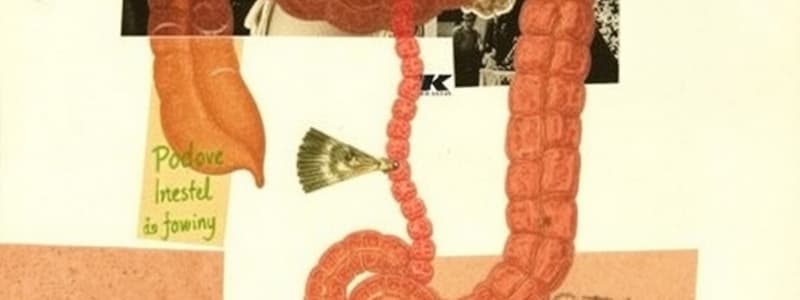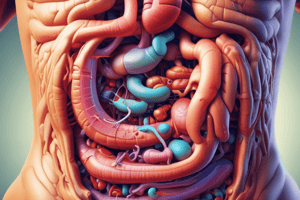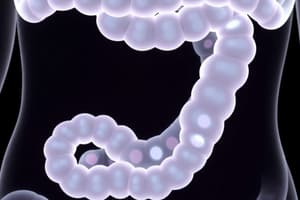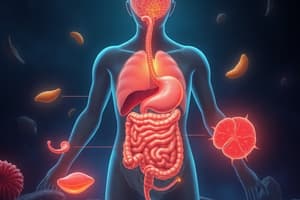Podcast
Questions and Answers
Absorption occurs through the activity of enzymes that catalyze carbohydrates, lipids, and proteins.
Absorption occurs through the activity of enzymes that catalyze carbohydrates, lipids, and proteins.
False (B)
Absorption takes place in the pharynx or the esophagus.
Absorption takes place in the pharynx or the esophagus.
False (B)
The presence of folds of Kerckring increases the surface area of the small intestine by 10 folds.
The presence of folds of Kerckring increases the surface area of the small intestine by 10 folds.
False (B)
The net increase in the surface area of the small intestine is about 600 folds.
The net increase in the surface area of the small intestine is about 600 folds.
What are the three main components of a villus?
What are the three main components of a villus?
Enteric innervation provides a mechanism to regulate the secretion of secretory cells and blood flow to intestinal mucosa.
Enteric innervation provides a mechanism to regulate the secretion of secretory cells and blood flow to intestinal mucosa.
Smooth muscle cells of the muscularis mucosa allow villi to wave in lumen and folds to move, which permit more spreading of chyme over the absorptive area.
Smooth muscle cells of the muscularis mucosa allow villi to wave in lumen and folds to move, which permit more spreading of chyme over the absorptive area.
Brush border enzymes help digest carbohydrates and proteins.
Brush border enzymes help digest carbohydrates and proteins.
Ptyalin is a salivary enzyme that helps break down starches into smaller polymers of glucose and a-limit dextrins.
Ptyalin is a salivary enzyme that helps break down starches into smaller polymers of glucose and a-limit dextrins.
The optimum activity of Ptyalin is at an acidic pH.
The optimum activity of Ptyalin is at an acidic pH.
The final digestion of carbohydrate is: glucose, fructose, galactose.
The final digestion of carbohydrate is: glucose, fructose, galactose.
Glucose is absorbed into the epithelial cells via a Na+ linked carrier, where Na+ and glucose bind to a specialized protein.
Glucose is absorbed into the epithelial cells via a Na+ linked carrier, where Na+ and glucose bind to a specialized protein.
The whole process of glucose absorption depends on the pumping of Na+ out of the enterocyte.
The whole process of glucose absorption depends on the pumping of Na+ out of the enterocyte.
The absorption of galactose is facilitated by a carrier that is not linked to Na+.
The absorption of galactose is facilitated by a carrier that is not linked to Na+.
Fructose enters by facilitated diffusion using a carrier that is linked to Na+.
Fructose enters by facilitated diffusion using a carrier that is linked to Na+.
About 60 grams of protein are digested and absorbed by the gut per day.
About 60 grams of protein are digested and absorbed by the gut per day.
Pepsin, an enzyme in the stomach, works optimally at a pH of 5-6.
Pepsin, an enzyme in the stomach, works optimally at a pH of 5-6.
Pepsin hydrolyzes around 80% of the proteins in the stomach.
Pepsin hydrolyzes around 80% of the proteins in the stomach.
Endopeptidases are proteolytic enzymes that hydrolyze peptide bonds, creating shorter peptides.
Endopeptidases are proteolytic enzymes that hydrolyze peptide bonds, creating shorter peptides.
Exopeptidases hydrolyze protein by converting it to small peptides and amino acids.
Exopeptidases hydrolyze protein by converting it to small peptides and amino acids.
Brush border peptidases convert large peptides into smaller peptides (di-, tri-, and tetra peptides) and amino acids.
Brush border peptidases convert large peptides into smaller peptides (di-, tri-, and tetra peptides) and amino acids.
Peptidases inside the cytosol of the enterocytes convert small peptides into amino acids.
Peptidases inside the cytosol of the enterocytes convert small peptides into amino acids.
Small peptides are transported into the enterocyte by simple diffusion.
Small peptides are transported into the enterocyte by simple diffusion.
A carrier mediated transport system requires energy.
A carrier mediated transport system requires energy.
What are the types of carriers that transport amino acids across the lumenal membrane?
What are the types of carriers that transport amino acids across the lumenal membrane?
Bile is needed for fat digestion and absorption.
Bile is needed for fat digestion and absorption.
Bile salts are amphipathic molecules with both hydrophilic and hydrophobic portions.
Bile salts are amphipathic molecules with both hydrophilic and hydrophobic portions.
The sterol nucleus of bile salts is hydrophilic.
The sterol nucleus of bile salts is hydrophilic.
The hydroxyl groups and amino acid conjugates of bile salts are hydrophobic.
The hydroxyl groups and amino acid conjugates of bile salts are hydrophobic.
Bile acids with more hydroxyl groups are more hydrophobic.
Bile acids with more hydroxyl groups are more hydrophobic.
Micelles form when the hydrophobic parts of bile salts orient inward (toward the center) and the hydrophilic parts orient outward (toward water).
Micelles form when the hydrophobic parts of bile salts orient inward (toward the center) and the hydrophilic parts orient outward (toward water).
There is significant fat digestion in the stomach.
There is significant fat digestion in the stomach.
Fats separate from the watery parts of the food, and exit the stomach more slowly than other components of the meal.
Fats separate from the watery parts of the food, and exit the stomach more slowly than other components of the meal.
Lipid digestion is not important for emulsifying fat in the duodenum.
Lipid digestion is not important for emulsifying fat in the duodenum.
Pancreatic lipase and colipase can act on the water/oil interface to hydrolyze the 1st and 3rd ester linkages of the tri glyceride between glycerol and fatty acids.
Pancreatic lipase and colipase can act on the water/oil interface to hydrolyze the 1st and 3rd ester linkages of the tri glyceride between glycerol and fatty acids.
There are brush border enzymes for lipid digestion.
There are brush border enzymes for lipid digestion.
Lipid transport is a carrier system in the lumenal membrane.
Lipid transport is a carrier system in the lumenal membrane.
The absorption of lipids is an active process in the lumenal membrane of the intestinal epithelial cell.
The absorption of lipids is an active process in the lumenal membrane of the intestinal epithelial cell.
Once inside the intestinal epithelial cell, free fatty acids and monoglycerides reform Triglycerides.
Once inside the intestinal epithelial cell, free fatty acids and monoglycerides reform Triglycerides.
Chylomicrons are a type of lipoprotein.
Chylomicrons are a type of lipoprotein.
Chylomicrons are expelled from the epithelial cells by exocytosis.
Chylomicrons are expelled from the epithelial cells by exocytosis.
Chylomicrons diffuse through the extracellular space and are removed from the villus via lymphatic vessels.
Chylomicrons diffuse through the extracellular space and are removed from the villus via lymphatic vessels.
Some glycerol molecules and short chain fatty acids pass directly through the epithelial cells and are removed from the villus by diffusion into blood capillaries.
Some glycerol molecules and short chain fatty acids pass directly through the epithelial cells and are removed from the villus by diffusion into blood capillaries.
Water absorption is driven by active transport of Na+ across the basolateral membrane which causes water to flow in through epithelial cells and the tight junction between the cells.
Water absorption is driven by active transport of Na+ across the basolateral membrane which causes water to flow in through epithelial cells and the tight junction between the cells.
Electrolytes are absorbed into the small intestine and colon.
Electrolytes are absorbed into the small intestine and colon.
There is a co-transport system with amino acids and monosaccharides for Na+ absorption.
There is a co-transport system with amino acids and monosaccharides for Na+ absorption.
Aldosterone, is a hormone secreted by the adrenal glands, which stimulates Na+ absorption. This is important mainly in the colon and helps to prevent water loss from the body.
Aldosterone, is a hormone secreted by the adrenal glands, which stimulates Na+ absorption. This is important mainly in the colon and helps to prevent water loss from the body.
Cl- is absorbed mainly in the upper part of the small intestine (duodenum and jejunum) by an active transport mechanism.
Cl- is absorbed mainly in the upper part of the small intestine (duodenum and jejunum) by an active transport mechanism.
K+ is absorbed actively in the small intestine.
K+ is absorbed actively in the small intestine.
Ca++ is actively absorbed throughout the intestine.
Ca++ is actively absorbed throughout the intestine.
Ca++ binds to a protein at the brush border membrane which might be a carrier.
Ca++ binds to a protein at the brush border membrane which might be a carrier.
Once Ca++ is inside the cell, it binds to a cytosolic Ca++ binding protein called calbindin, which transports Ca++ across the cell.
Once Ca++ is inside the cell, it binds to a cytosolic Ca++ binding protein called calbindin, which transports Ca++ across the cell.
Ca++ is secreted out at the basolateral membrane by passive diffusion.
Ca++ is secreted out at the basolateral membrane by passive diffusion.
Ca++ absorption is increased by vitamin D and parathyroid hormone.
Ca++ absorption is increased by vitamin D and parathyroid hormone.
Iron absorption is mainly in the upper part of the small intestine (duodenum and the adjacent jejunum).
Iron absorption is mainly in the upper part of the small intestine (duodenum and the adjacent jejunum).
Iron absorption is promoted by a basic pH in the stomach and vitamin C.
Iron absorption is promoted by a basic pH in the stomach and vitamin C.
Fe++ (ferrous iron) is much less soluble than Fe+++ (ferric iron).
Fe++ (ferrous iron) is much less soluble than Fe+++ (ferric iron).
The effect of Vitamin C in enhancing iron absorption in the small intestine, is by reducing the ferric iron to ferrous iron.
The effect of Vitamin C in enhancing iron absorption in the small intestine, is by reducing the ferric iron to ferrous iron.
Phosphates, oxalates, phytic acid (found in cereals) and pancreatic juice enhance the absorption of iron.
Phosphates, oxalates, phytic acid (found in cereals) and pancreatic juice enhance the absorption of iron.
The mechanisms of iron absorption are well understood.
The mechanisms of iron absorption are well understood.
Iron is stored in the epithelial cell in the form of ferritin, then transported into the blood where it binds to transferrin as needed.
Iron is stored in the epithelial cell in the form of ferritin, then transported into the blood where it binds to transferrin as needed.
If NOT needed, iron is lost when the cell sheds. This mechanism prevents excess iron from entering the blood from the cell and causing toxic effects.
If NOT needed, iron is lost when the cell sheds. This mechanism prevents excess iron from entering the blood from the cell and causing toxic effects.
Most vitamins are absorbed in the upper part of the small intestine.
Most vitamins are absorbed in the upper part of the small intestine.
Water-soluble vitamins (Vit. C, Vit. B1, and Vit. B12) are absorbed passively except: Vit. B12.
Water-soluble vitamins (Vit. C, Vit. B1, and Vit. B12) are absorbed passively except: Vit. B12.
Lipid-soluble vitamins (Vit. A, D, E, K) follow the same route as lipids, where they are solubilized in micelles and chylomicrons.
Lipid-soluble vitamins (Vit. A, D, E, K) follow the same route as lipids, where they are solubilized in micelles and chylomicrons.
Flashcards
Digestion
Digestion
The process by which food is broken down into smaller molecules that can be absorbed by the body.
Absorption
Absorption
The process of taking nutrients from digested food into the bloodstream.
Small intestine
Small intestine
The part of the digestive system where most absorption takes place.
Villi
Villi
Signup and view all the flashcards
Microvilli
Microvilli
Signup and view all the flashcards
Folds of Kerckring
Folds of Kerckring
Signup and view all the flashcards
Capillary network
Capillary network
Signup and view all the flashcards
Lacteals
Lacteals
Signup and view all the flashcards
Enteric innervation
Enteric innervation
Signup and view all the flashcards
Digestive enzymes
Digestive enzymes
Signup and view all the flashcards
Starch
Starch
Signup and view all the flashcards
Ptyalin (Salivary alpha-amylase)
Ptyalin (Salivary alpha-amylase)
Signup and view all the flashcards
Pancreatic amylase
Pancreatic amylase
Signup and view all the flashcards
Brush border enzymes
Brush border enzymes
Signup and view all the flashcards
Glucose
Glucose
Signup and view all the flashcards
Galactose
Galactose
Signup and view all the flashcards
Fructose
Fructose
Signup and view all the flashcards
Carbohydrate absorption
Carbohydrate absorption
Signup and view all the flashcards
Active transport
Active transport
Signup and view all the flashcards
Secondary active transport
Secondary active transport
Signup and view all the flashcards
Facilitated diffusion
Facilitated diffusion
Signup and view all the flashcards
Pepsin
Pepsin
Signup and view all the flashcards
Pancreatic proteolytic enzymes
Pancreatic proteolytic enzymes
Signup and view all the flashcards
Brush border peptidases
Brush border peptidases
Signup and view all the flashcards
Protein absorption
Protein absorption
Signup and view all the flashcards
Bile
Bile
Signup and view all the flashcards
Amphipathic molecules
Amphipathic molecules
Signup and view all the flashcards
Micelles
Micelles
Signup and view all the flashcards
Pancreatic lipase
Pancreatic lipase
Signup and view all the flashcards
Lipid absorption
Lipid absorption
Signup and view all the flashcards
Study Notes
Digestion and Absorption
- Digestion occurs via enzymes that break down carbohydrates, lipids, and proteins.
- Absorption happens through specialized epithelial cells.
- No absorption takes place in the pharynx or esophagus.
- A small amount of absorption occurs in the stomach, but the majority in the small intestine.
- The small intestine's increased absorptive capacity is due to specialized structures.
- Most nutrients are absorbed before reaching the ileum.
- The colon absorbs electrolytes and water.
Intestinal Specialization
- Folds of Kerckring (circular folds) increase the intestinal surface area threefold.
- Villi are structures in the mucosa that increase surface area tenfold.
- Microvilli on epithelial cells further increase the surface area twentyfold.
- The combined effect is approximately 600 times more surface area
Carbohydrate Digestion and Absorption
- Carbohydrates are ingested mainly as starch (linked by alpha 1-4 and 1-6 bonds), sucrose, and lactose.
- Cellulose (glucose linked by beta 1-4) is indigestible.
- Digestion begins in the mouth with salivary alpha-amylase, breaking down starches.
- Pancreatic amylase further breaks down starches in the small intestine.
- Brush border enzymes (maltase, lactase, sucrase, isomaltase) hydrolyse specific disaccharides.
- Glucose, fructose, and galactose are the end products of carbohydrate digestion.
- Glucose absorption is active, requiring Na+ cotransport.
- Fructose and galactose also use facilitated diffusion to enter the cell.
Protein Digestion and Absorption
- Proteins are polymers of amino acids linked by peptide bonds.
- Stomach digestion starts with pepsin (activated by HCl).
- Pancreatic enzymes (trypsin, chymotrypsin, carboxypeptidase) further break down peptides in the small intestine.
- Brush border enzymes (peptidases) break down peptides to amino acids.
- Di- and tri-peptides are transported into the enterocyte via a Na+ dependent carrier.
- Amino acids are transported across the basolateral membrane by specific carrier proteins.
Lipid Digestion and Absorption
- Fats are primarily triglycerides, with some phospholipids and cholesterol.
- Digestion begins in the small intestine with bile salts, which emulsify fats.
- Pancreatic lipase hydrolyzes triglycerides into fatty acids and monoglycerides.
- These products, along with other lipids, form micelles.
- Micelles carry these lipids to the epithelial cells, where they are absorbed passively.
- Absorbed lipids combine with proteins to form chylomicrons.
- Chylomicrons are transported via the lymphatic system.
Water and Electrolyte Absorption
- Water absorption is driven by active transport of Na+ creating a concentration gradient that pulls water into the cell.
- Active Na+ absorption occurs via the basolateral membrane.
- Some electrolytes like Chloride (Cl-) and Potassium (K+) are absorbed by passive diffusion.
- The presence of aldosterone affects these absorption processes.
Vitamin Absorption
- Water-soluble vitamins (except for B12) are absorbed passively.
- Vitamin B12 absorption requires intrinsic factor, secreted by stomach cells.
- Lipid-soluble vitamins (A, D, E, K) follow the same route as lipid absorption.
Calcium Absorption
- Calcium is actively absorbed throughout the intestine via a protein transporter called Calbindin.
- Active transport occurs at the basolateral membrane.
- Absorption is enhanced with vitamin D and parathyroid hormone levels
Iron Absorption
- Iron absorption primarily occurs in the duodenum and jejunum.
- Ferrous iron is more easily absorbed than ferric iron.
- Vitamin C enhances iron absorption.
- Phosphates, oxalates, and phytic acid can inhibit iron absorption.
Studying That Suits You
Use AI to generate personalized quizzes and flashcards to suit your learning preferences.




